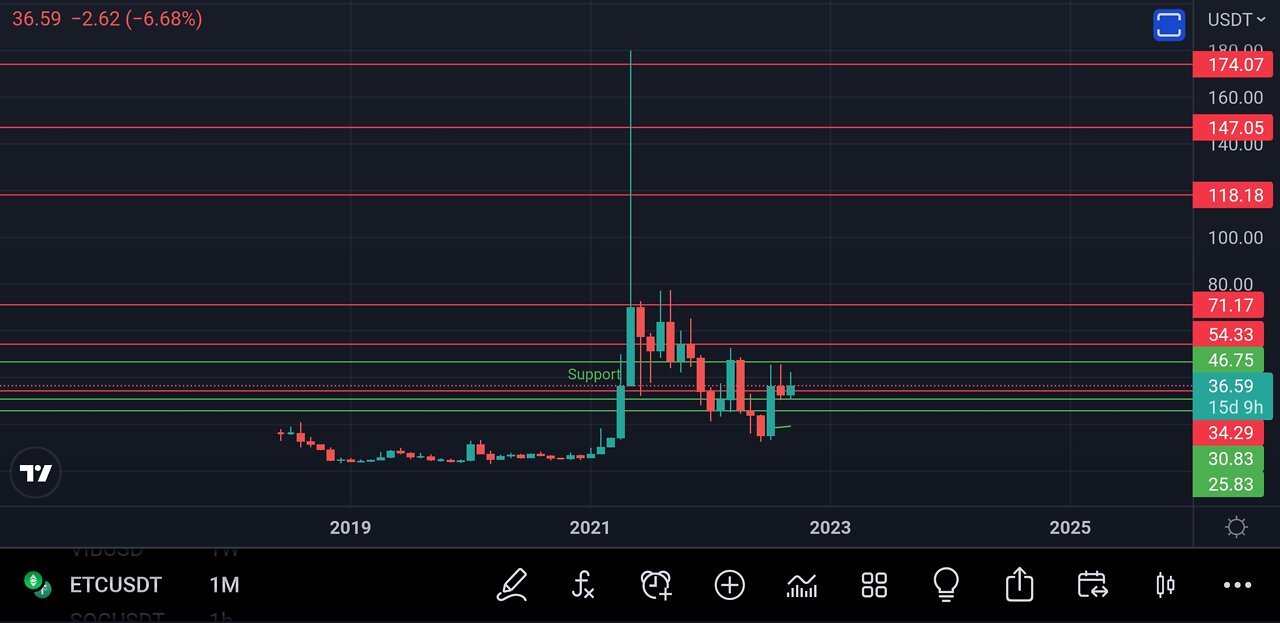Premium Only Content

ETC Coin | Etherium Classic Coin Price Levels
What Is Ethereum Classic (ETC)?
Ethereum Classic (ETC) is a hard fork of Ethereum (ETH) that launched in July 2016. Its main function is as a smart contract network, with the ability to host and support decentralized applications (DApps). Its native token is ETC.
Since its launch, Ethereum Classic has sought to differentiate itself from Ethereum, with the two networks’ technical roadmap diverging further and further from each other with time.
Ethereum Classic first set out to preserve the integrity of the existing Ethereum blockchain after a major hacking event led to the theft of 3.6 million ETH.
Who Are the Founders of Ethereum Classic?
Ethereum Classic is in fact the legacy chain of Ethereum, and its true creators are therefore the original Ethereum developers — Vitalik Buterin and Gavin Wood.
A contentious hard fork on Ethereum occurred in July 2016, when participants disagreed over whether to revert the blockchain to cancel out the effects of a major hack. This impacted The DAO, a decentralized autonomous organization (DAO) which had raised approximately $150 million in an initial coin offering (ICO) several months earlier.
Ethereum Classic came into being as the network which did not revert the chain. Developers state that there is no “official” team attached to the project, and that its “global development community is a permissionless 'do-ocracy,' where anyone can participate.”
What Makes Ethereum Classic Unique?
Ethereum Classic’s main aim is to preserve the Ethereum blockchain as it originally was, without artificially countering the DAO hack.
Its appeal was first to those who disagreed with Ethereum’s response, but the legacy network has since gained a wider fan base, which include major investors such as Barry Silbert, CEO of investment firm Grayscale.
As a voluntary organization, the developers of ETC do not aim to turn the network into a for-profit entity. Users pay transaction fees as with Ethereum, and miners collect them based on work done as per the proof-of-work (PoW) mining algorithm.
Unlike Ethereum, Ethereum Classic has no plans to convert to a proof-of-stake (PoS) mining algorithm, while multiple developers continue to work on future improvements such as scaling solutions.
How Many Ethereum Classic (ETC) Coins Are There In Circulation?
ETC began in a very similar technical state to ETH, with the exception of how the DAO hack transactions were handled.
Since launch, however, changes in tokenomics have occurred, with participants voting to cap the supply of ETC in December 2017. The maximum supply is thus 210,700,000 ETC, roughly ten times that of Bitcoin (BTC), while ETH has no cap.
ETC uses a PoW mining algorithm, which functions like Bitcoin — miners are rewarded with new coins for validating the blockchain in competition with each other. The ETC block reward decreases with time, with the next drop due at block 15,000,000, roughly in April 2022 — from 3.2 ETC to 2.56 ETC per block.
How Is the Ethereum Classic Network Secured?
The Ethereum Classic network is secured using proof-of-work, but as a minority chain, it has suffered regular attacks itself.
These include several 51% attacks to gain control of mining hashrate and execute spurious transactions and double spend coins, the most recent of which occurred in August 2020.
Where Can You Buy Ethereum Classic (ETC)?
ETC is a major market cap cryptocurrency and is freely tradable on a large number of major exchanges.
Pairs are available against stablecoins, other cryptocurrencies and fiat currencies, while derivatives and institutional investment vehicles also exist. Exchanges that let you buy Ethereum Classic include Binance, OKEx and Huobi Global.
Crypto newbie? Read our easy guide to buying Bitcoin and any other cryptocurrency.
-
 3:41:12
3:41:12
Fresh and Fit
14 hours agoDaniel Penny ACQUITTED & BLM Meltdown
109K29 -
 42:46
42:46
barstoolsports
12 hours agoThe Shred Line with Coach Gruden, Dave Portnoy and Steven Cheah | Week 15
74.4K5 -
 3:43:53
3:43:53
EricJohnPizzaArtist
9 hours agoAwesome Sauce PIZZA ART LIVE Ep. #27: Christmas Special! Dr. Disrespect is Coming to Town!
46.1K9 -
 1:42:14
1:42:14
TheDozenPodcast
15 hours agoConor McGregor, Raoul Moat, Burglary, BKFC Heavyweight Champion: Mick Terrill
72.4K3 -
 2:10:02
2:10:02
vivafrei
18 hours agoEp. 241: Stephanopoulos PAYS for Defamation! Accused CEO Shooter Gets ELITE Attorney! Drone Madness
192K126 -
 6:05:13
6:05:13
Right Side Broadcasting Network
6 days agoLIVE REPLAY: NYYRC 112th Annual Gala Ft. Steve Bannon, Nigel Farage, and Dan Scavino - 12/15/24
240K16 -
 1:22:45
1:22:45
Josh Pate's College Football Show
13 hours ago $5.14 earnedCFP First Round Predictions | Travis Hunter Heisman | Transfer Portal Intel | Biggest Misses In 2024
47.6K -
 LIVE
LIVE
Vigilant News Network
12 hours agoTsunami of Devastating News Crashes Down on COVID Vaccines | Media Blackout
1,381 watching -
 5:07:03
5:07:03
SLS - Street League Skateboarding
5 days ago2024 SLS Super Crown São Paulo: Men's & Women's FINAL
1.46M125 -
 32:51
32:51
The Why Files
21 days agoCryptids 2: Electric Boogaloo. Four creatures following the same electromagnetic pattern.
170K160